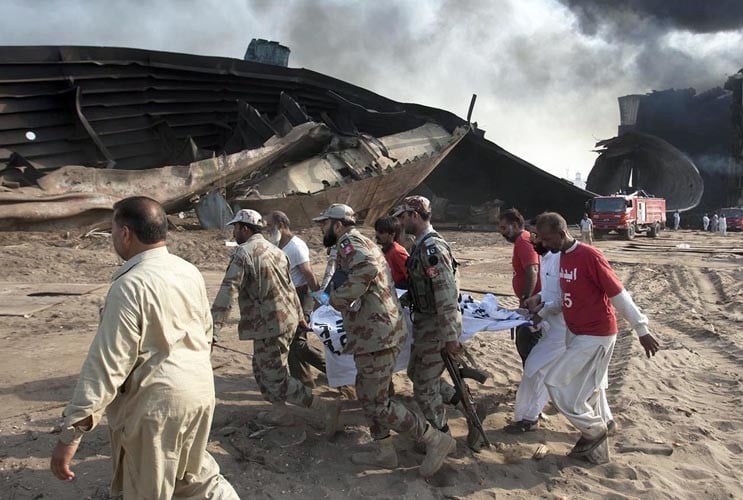
Safety of the worker must be the priority of a contractor before starting a development project

A number of tragic incidents that occurred in the country recently caused grief and anguish in the working class and the civil society. The fire in Gadani ship-breaking yard annihilated more than two dozen workers in the most abominable conditions.
On January 11, the tragic death of workers at the Orange Line site in Lahore exposed how vulnerable our working class is to accidents. Someone familiar with the working of formal and informal enterprises in services and manufacturing sector may be aware about the predicaments faced by workers across the country.
Coal miners in the rough terrains of Balochistan, kiln workers in Punjab, welding apprentices in Sindh or construction labour in Khyber Pakhtunkhwa, workplace dangers that haunt these hard working folks are mostly the same.
A bulk of the unskilled labour that works in various sectors is hired on contract. Influential contractors access task contracts through their links in the respective sector. The main objective of such contractors is to minimise the input cost to a minimum in order to maximise profits.
While investment in procuring material and hardware is small, very few, if any, facilities are provided to the labour. One does not find any first aid or ambulance service in case of an emergency. For machine operators and handlers of hazardous tools and plants, a small mistake can prove fatal. Many issues need to be examined.
Pakistan possesses an elaborate set of laws, statues, and covenants to deal with issues of occupational safety. Many of them have their origin in the British colonial times. Factories Act of 1934, Dock Labourers Act of 1934, Mines Act of 1923, and Workmen Compensation Act of 1923 are a few examples.
These laws provide the vital statutory cover for overseeing issues, such as general cleanliness of the workplace, ventilation and fumes control, dust and suspended particles management, provision of essential facilities, such as first aid, clean drinking water, lavatories, vaccination and site management for the well-being of labour.
Similarly, a well laid out manual is available that governs the working norms in mining. The enforcement of these statutes becomes the responsibility of respective provincial and federal government. The relevant government department is mandated to oversee the working of such enterprises through a pool of inspectors to ensure that the prescribed conditions and props are provided at the working site. But the rules are seldom implemented.
On August 4, last year, three workers died in an accident in the state-owned Shahrigh coal mines in Balochistan. Inappropriate safety arrangements were cited as the cause of the tragic episode. It is disappointing to note that since 2010, 243 workers have died in around 40 mine accidents in the country.
Poor mine conditions, erratic and infrequent mine inspections, absence of basic medical and emergency facilities and callous attitude of employers and government officials are some of the causes of accidents that can be avoided.
Construction workers of skilled and unskilled category are another major category of labour. Development of roads and highways, construction of large and medium-scale buildings, repairs and expansion of various facilities, hydro-infrastructure, such as dams, canals and water ways are some of the areas where this vast category of labour is engaged in. They are mostly employed through contractual arrangements by the contractors or labour-supplying enterprises. Thus, the rights and privileges are almost non-existent for this captive labour force.
It is found that they are exposed to multiple hazards of various kinds, many of which lead to fatalities. While excavating in deep terrains, often the trench walls cave in and cause death of workers. The contractors seldom provide precautionary equipment to prevent. Protective gloves and other gears are not provided.
Labourers also sometimes fall down from scaffoldings as safety belts are not provided. At times, contractors use worn-out shuttering and scaffolding that come down due to the load of material or workers. One also does not find safety helmets, leading to head injuries from falling material or stones. Another sad aspect is that accidents are not always reported. It is often the media that points out an accident.
Healthcare workers are also prone to many forms of occupational hazards. Violence is also caused in public (and also private) hospitals by the attendants of a patient on the doctors, nurses and para-medical staff. A study carried out by researchers of King Edward Medical University revealed that 74 per cent of the surveyed professionals admitted that they were subjected to violence of some kind.
Unchecked exposure to contagious and hazardous diseases is another serious issue. Healthcare workers may contract diseases while attempting to treat patients. Immunisation workers, especially those dealing with polio campaigns, have been vulnerable. Many lady workers have also been targeted. It is believed that misconceptions and suspicions are principle reason for this.
There is a need for improving this situation. The government must initiate a focused drive for implementing safety prescriptions in the existing laws. An overseeing mechanism must be created at the district level, comprising municipal councilors, industrial relations organizations, such as Pakistan Institute of Labour Education and Research (PILER), employers’ bodies, such as Employers Federations of Pakistan and labour representatives.
Labour supervisors should be provided training for ensuring compliance with occupational safety rules. Inspection procedures for mines and their frequency must be made mandatory without any lapse.